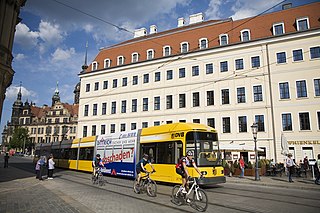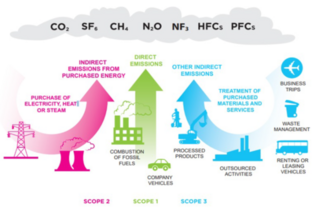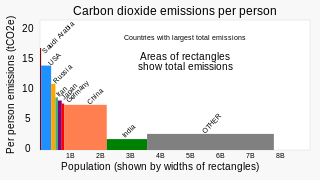Related Research Articles

Sustainable transport refers to ways of transportation that are sustainable in terms of their social and environmental impacts. Components for evaluating sustainability include the particular vehicles used for road, water or air transport; the source of energy; and the infrastructure used to accommodate the transport. Transport operations and logistics as well as transit-oriented development are also involved in evaluation. Transportation sustainability is largely being measured by transportation system effectiveness and efficiency as well as the environmental and climate impacts of the system. Transport systems have significant impacts on the environment, accounting for between 20% and 25% of world energy consumption and carbon dioxide emissions. The majority of the emissions, almost 97%, came from direct burning of fossil fuels. In 2019, about 95% of the fuel came from fossil sources. The main source of greenhouse gas emissions in the European Union is transportation. In 2019 it contributes to about 31% of global emissions and 24% of emissions in the EU. In addition, up to the COVID-19 pandemic, emissions have only increased in this one sector. Greenhouse gas emissions from transport are increasing at a faster rate than any other energy using sector. Road transport is also a major contributor to local air pollution and smog.

Green building refers to both a structure and the application of processes that are environmentally responsible and resource-efficient throughout a building's life-cycle: from planning to design, construction, operation, maintenance, renovation, and demolition. This requires close cooperation of the contractor, the architects, the engineers, and the client at all project stages. The Green Building practice expands and complements the classical building design concerns of economy, utility, durability, and comfort. Green building also refers to saving resources to the maximum extent, including energy saving, land saving, water saving, material saving, etc., during the whole life cycle of the building, protecting the environment and reducing pollution, providing people with healthy, comfortable and efficient use of space, and being in harmony with nature. Buildings that live in harmony; green building technology focuses on low consumption, high efficiency, economy, environmental protection, integration and optimization.’

Uddhav Bal Thackeray is an Indian politician who served as the 19th Chief Minister of Maharashtra from 2019 to 2022 and the Leader of the House, Maharashtra Legislative Assembly from 2019 to 2022. He is a member of Maharashtra Legislative Council since 2020, the president of Maha Vikas Aghadi since 2019 and the president of Shiv Sena since 2022. He was also the leader (pramukh) of Shiv Sena from 2013 to 2022, working President from 2003 to 2013 and the editor-in-chief of Saamana from 2006 to 2019.

A sustainable city, eco-city, or green city is a city designed with consideration for social, economic, environmental impact, and resilient habitat for existing populations, without compromising the ability of future generations to experience the same. The UN Sustainable Development Goal 11 defines sustainable cities as those that are dedicated to achieving green sustainability, social sustainability and economic sustainability. They are committed to doing so by enabling opportunities for all through a design focused on inclusivity as well as maintaining a sustainable economic growth. The focus will also includes minimizing required inputs of energy, water, and food, and drastically reducing waste, output of heat, air pollution – CO2, methane, and water pollution. Richard Register, a visual artist, first coined the term ecocity in his 1987 book Ecocity Berkeley: Building Cities for a Healthy Future, where he offers innovative city planning solutions that would work anywhere. Other leading figures who envisioned sustainable cities are architect Paul F Downton, who later founded the company Ecopolis Pty Ltd, as well as authors Timothy Beatley and Steffen Lehmann, who have written extensively on the subject. The field of industrial ecology is sometimes used in planning these cities.

Carbon accounting is a framework of methods to measure and track how much greenhouse gas (GHG) an organization emits. It can also be used to track projects or actions to reduce emissions in sectors such as forestry or renewable energy. Corporations, cities and other groups use these techniques to help limit climate change. Organizations will often set an emissions baseline, create targets for reducing emissions, and track progress towards them. The accounting methods enable them to do this in a more consistent and transparent manner.

C40 Cities Climate Leadership Group is a group of 96 cities around the world that represents one twelfth of the world's population and one quarter of the global economy. Created and led by cities, C40 is focused on fighting the climate crisis and driving urban action that reduces greenhouse gas emissions and climate risks, while increasing the health, wellbeing and economic opportunities of urban residents.

A zero-carbon city is a goal of city planners that can be variously defined. In a narrower sense of energy production and use, a zero-carbon city is one that generates as much or more carbon-free sustainable energy as it uses. In a broader sense of managing greenhouse gas emissions, a zero-carbon city is one that reduces its carbon footprint to a minimum by using renewable energy sources; reducing all types of carbon emissions through efficient urban design, technology use and lifestyle changes; and balancing any remaining emissions through carbon sequestration. Since the supply chains of a city stretch far beyond its borders, Princeton University's High Meadows Environmental Institute suggests using a transboundary definition of a net-zero carbon city as "one that has net-zero carbon infrastructure and food provisioning systems".
The Chicago Climate Action Plan (CCAP) is Chicago's climate change mitigation and adaptation strategy that was adopted in September 2008. The CCAP has an overarching goal of reducing Chicago's greenhouse gas emissions to 80 percent below 1990 levels by 2050, with an interim goal of 25 percent below 1990 levels by 2020.

Green urbanism has been defined as the practice of creating communities beneficial to humans and the environment. According to Timothy Beatley, it is an attempt to shape more sustainable places, communities and lifestyles, and consume less of the world's resources. Urban areas are able to lay the groundwork of how environmentally integrated and sustainable city planning can both provide and improve environmental benefits on the local, national, and international levels. Green urbanism is interdisciplinary, combining the collaboration of landscape architects, engineers, urban planners, ecologists, transport planners, physicists, psychologists, sociologists, economists and other specialists in addition to architects and urban designers.

Climate change has resulted in an increase in temperature of 2.3 °C (2022) in Europe compared to pre-industrial levels. Europe is the fastest warming continent in the world. Europe's climate is getting warmer due to anthropogenic activity. According to international climate experts, global temperature rise should not exceed 2 °C to prevent the most dangerous consequences of climate change; without reduction in greenhouse gas emissions, this could happen before 2050. Climate change has implications for all regions of Europe, with the extent and nature of impacts varying across the continent.

Wong Kam-sing, GBS, JP, is a Hong Kong architect and the former Secretary for the Environment, Wong had held a number of public service positions before joining the Government, including the first Chairman of the Environment and Sustainable Development Committee of the Hong Kong Institute of Architects, the Chairman of the Professional Green Building Council and the Vice Chairman of the Hong Kong Green Building Council. He has contributed to the promotion and research of the standards and guidelines for sustainable built environment applicable to the high-density urban environment of Hong Kong.
The C40 Cities Climate Leadership Group’s Climate Positive Development Program (Climate Positive) was launched in May 2009 in partnership with the Clinton Climate Initiative and the U.S. Green Building Council. The program brings together leading district-scale new-build and regeneration projects working to achieve "Climate Positive"—or net carbon negative—outcomes in cities around the world. As part of the C40’s Sustainable Communities Initiative, it aims to create a model for large-scale urban communities and to support projects that serve as urban laboratories for cities seeking to grow in ways that are environmentally sustainable, climate resilient, and economically viable.

The World Resources Institute (WRI) is a global research non-profit organization established in 1982 with funding from the MacArthur Foundation under the leadership of James Gustave Speth. Subsequent presidents include Jonathan Lash, Andrew D. Steer and current president Ani Dasgupta (2021-).

China's greenhouse gas emissions are the largest of any country in the world both in production and consumption terms, and stem mainly from coal burning, including coal power, coal mining, and blast furnaces producing iron and steel. When measuring production-based emissions, China emitted over 14 gigatonnes (Gt) CO2eq of greenhouse gases in 2019, 27% of the world total. When measuring in consumption-based terms, which adds emissions associated with imported goods and extracts those associated with exported goods, China accounts for 13 gigatonnes (Gt) or 25% of global emissions.

The European Green Deal, approved in 2020, is a set of policy initiatives by the European Commission with the overarching aim of making the European Union (EU) climate neutral in 2050. The plan is to review each existing law on its climate merits, and also introduce new legislation on the circular economy, building renovation, biodiversity, farming and innovation.
Green recovery packages are proposed environmental, regulatory, and fiscal reforms to rebuild prosperity in the wake of an economic crisis, such as the COVID-19 pandemic or the Global Financial Crisis (GFC). They pertain to fiscal measures that intend to recover economic growth while also positively benefitting the environment, including measures for renewable energy, efficient energy use, nature-based solutions, sustainable transport, green innovation and green jobs, amongst others.

The Netherlands is already affected by climate change. The average temperature in the Netherlands rose by more than 2 °C from 1901 to 2020. Climate change has resulted in increased frequency of droughts and heatwaves. Because significant portions of the Netherlands have been reclaimed from the sea or otherwise are very near sea level, the Netherlands is very vulnerable to sea level rise.

Climate change and cities are deeply connected. Cities are one of the greatest contributors and likely best opportunities for addressing climate change. Cities are also one of the most vulnerable parts of the human society to the effects of climate change, and likely one of the most important solutions for reducing the environmental impact of humans. The UN projects that 68% of the world population will live in urban areas by 2050. In the year 2016, 31 mega-cities reported having at least 10 million in their population, 8 of which surpassed 20 million people. However, secondary cities - small to medium size cities are rapidly increasing in number and are some of the fastest growing urbanizing areas in the world further contributing to climate change impacts. Cities have a significant influence on construction and transportation—two of the key contributors to global warming emissions. Moreover, because of processes that create climate conflict and climate refugees, city areas are expected to grow during the next several decades, stressing infrastructure and concentrating more impoverished peoples in cities.
Various environmental issues are facing Wales, including climate change, pollution and ecosystem loss, and the various policies to address them.
TransformTO is a plan adopted by the City of Toronto to bring the city to carbon neutrality by 2040. The plan was adopted by city council unanimously in July 2017, and has components addressing buildings, transportation, waste, and natural systems. The plan initially started in response to the 2016 Paris Agreement, aiming to reach net-zero carbon emissions by 2050, but the timeline was accelerated following the council's 2019 declaration of a climate emergency by city council.
References
- 1 2 "Aaditya unveils Climate Action Plan for Mumbai". The Hindu. 27 August 2021 – via www.thehindu.com.
- ↑ "City sets green targets for 2050 as Mumbai's Climate Action Plan unveiled". The Indian Express. 14 March 2022. Retrieved 14 March 2022.
- ↑ "Mumbai's climate plan aims for carbon neutrality 20 years ahead of India | Mumbai News - Times of India". The Times of India. TNN. 14 March 2022. Retrieved 14 March 2022.
- 1 2 "Mumbai Climate Action Plan: What is it, and why does the city need one?". The Indian Express. 31 August 2021.
- ↑ Richa Pinto (27 August 2021). "BMC launches Mumbai Climate Action Plan with focus on six areas | Mumbai News - Times of India". The Times of India. Retrieved 3 March 2022.
- ↑ "CM Uddhav Thackeray launches Mumbai Climate Action Plan". Hindustan Times. 13 March 2022. Retrieved 14 March 2022.
- ↑ "Mumbai: Maharashtra government launches country's first climate action plan for Mumbai". TimesNow. 14 March 2022. Retrieved 14 March 2022.
- ↑ "Rise in Mumbai's average temperature due to increase in built-up area: Study". Deccan Herald. 18 October 2021. Retrieved 3 March 2022.
- ↑ Kiran Tare (6 September 2021). "Why South Mumbai could be submerged by 2050". India Today. Retrieved 3 March 2022.
- ↑ Livemint (29 August 2021). "Mumbai: '80% of Nariman point, Mantralaya areas will be submerged by 2050'". mint. Retrieved 3 March 2022.
- ↑ "India's megacities, Mumbai and Delhi, sitting on a pile of waste". Mongabay-India. 11 October 2019. Retrieved 4 March 2022.
- ↑ Yadav, Himanshu; Kumar, Pawan; Singh, V. P. (2019). "Hazards from the Municipal Solid Waste Dumpsites: A Review". In Singh, Harvinder; Garg, Prashant; Kaur, Inderpreet (eds.). Proceedings of the 1st International Conference on Sustainable Waste Management through Design. Lecture Notes in Civil Engineering. Vol. 21. Cham: Springer International Publishing. pp. 336–342. doi:10.1007/978-3-030-02707-0_39. ISBN 978-3-030-02707-0. S2CID 134008993.
- 1 2 "Home". Mumbai Climate Action Plan. Retrieved 14 March 2022.
- ↑ "Mumbai: Experts say decentralisation is the key". DNA India. Retrieved 4 March 2022.
- ↑ "Areas in Mumbai with less green cover, more concrete are warmer: Study". The Indian Express. 9 September 2021. Retrieved 14 March 2022.
- ↑ Richa Pinto (9 September 2021). "Mumbai: Low-income wards lack green spaces, finds climate study | Mumbai News - Times of India". The Times of India. Retrieved 14 March 2022.
- ↑ Prakash, Priyali (18 March 2022). "Explained | What is the Mumbai Climate Action Plan?". The Hindu. ISSN 0971-751X . Retrieved 22 March 2022.
- ↑ "Key Action Areas". Mumbai Climate Action Plan. Retrieved 22 March 2022.
- ↑ "Mumbai Climate Action Plan - In Focus". C40 Cities. Retrieved 24 May 2023.